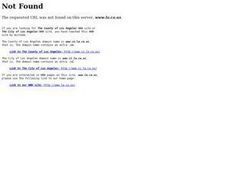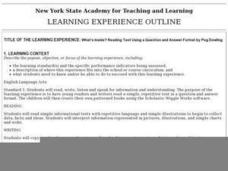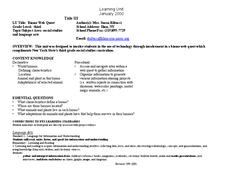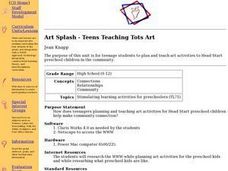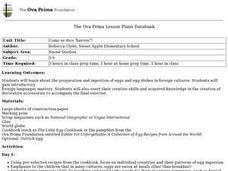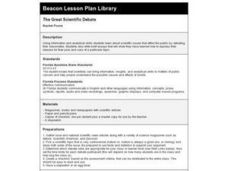Curated OER
Build a Forest
Students discuss various types of trees. For this forest structure lesson, students cut out pictures of a wide variety of trees and paste the pictures onto index cards. Students identify each tree and present information about each...
Curated OER
Current Event Jeopardy
Students read current event magazines and newspapers, and highlight questions and answers that are to be used for a class Jeopardy Game. They participate in class Jeopardy Game.
Curated OER
Developing Open-Ended Questions
Pupils work in groups of two to develop questions and sample answers that are relevant, accurate and use higher level of thinking skills about a literary unit. Students present their questions and answers to the class as a review of the...
Curated OER
Governments of the World
Young scholars examine how different world governments function and interact with each other. In groups, they research one of the five types of governments. Students prepare news magazines, Powerpoint presentations, and newspaper...
Curated OER
Fashion Forward, Fashion Functional
Students consider the implications of waste. In this waste streams lesson plan, students learn what waste streams are and identify their impact on the environment. Students also recycle waste materials to create functional objects.
Curated OER
Creating an Instructional Manual
Ninth graders create an instructional manual about using a mechanical device. In this technical writing lesson, 9th graders create a PowerPoint presentation that includes the step by step process of how to use the mechanical device.
Curated OER
Infusing Equity by Gender into the Classroom
Students discover the biases between the two genders by comparing males and females in different species. In this gender identity lesson, students research National Geographic Magazine and view videos demonstrating the differences...
Curated OER
The Dust Bowl
Eleventh graders develop an understanding of the Dust Bowl. In this 1930's America lesson, 11th graders respond to questions regarding the songs and literature about the era. The primary sources should be gathered by the instructor.
Curated OER
Recognizing Advertising Techniques
Learners explore advertising techniques. In this media awareness lesson, students read articles about foods and their links to childhood obesity. Learners also discuss propaganda techniques that advertisers use to sell certain foods.
Curated OER
Making Headlines
Young scholars consider their personal opinions about the news and politics, read about the public relations drive behind the 2004 presidential election, and gather information for a press release promoting either Mr. Bush or Mr. Kerry.
Curated OER
What's Inside? Reading Text Using a Question and Answer Format
Students use a variety of print media to copy words from. They listen for facts while the teacher reads to them. They listen to a book about eggs and write a book of their own.
Curated OER
Speaking of the Speaker
Learners deconstruct an obituary and examine the elements and incidents of a person's life that were chosen to memorialize in an obituary. They research a notable American and write and obituary about their life.
Curated OER
Biome Web Quest
Third graders create paper mache globes, paint them and label the oceans and the continents. In groups, they research a biome, write about it and create an artistic visual representation of the biome and present it to the class.
Curated OER
Cite Your Sites!
The New York Times article “Lessons in Internet Plagiarism,” launches a look at how the Internet has increased the prevalence of plagiarism. The richly detailed activity includes warm-up and wrap-up activities, discussion questions,...
Curated OER
Teens Teaching Tots Art
Students plan and teach art activities to Head Start preschool students in the community. Students research the WWW while planning art activities for the preschool kids and while researching what preschool kids are like.Students...
Curated OER
Reviewing the Scientific Process
Students investigate the scientific method by reading science journals. In this scientific research lesson, students read several articles of the National Inquirer and analyze the specific parts of an article. Students...
Curated OER
Real Attractive
Sixth graders create a collage of attractive people. They write about what makes these people attractive. They discuss what makes someone attractive. They research eating disorders and how the media impacts what people deem as attractive.
Curated OER
Como se dice 'huevos'?
Learners research about the preparation and ingestion of eggs and egg dishes in foreign cultures. Students gain introductory
foreign languages mastery. Learners also exert their creative skills and acquired knowledge in the creation of...
Curated OER
Creating your Frog's Environment
Students discuss where frogs can live. After the discussion, they create an environment for a frog using items of their choice. Some may include: construction paper, paint, magazines. The environment could even be 3-D. The key to this...
Curated OER
What's Wild?
Third graders examine pictures of animals before deciding if it is a wild animal or a domesticated animal. They discuss the difference between the two types of animals, where they live, what they eat, and what they need to survive. Using...
Curated OER
The Great Scientific Debate
Fourth graders examine scientific issues that affect the public by debating their classmates. They also write brief essays that show they have learned how to express their reasons for their pros and cons of a particular topic.
Curated OER
Wild Or Domestic?
Students discuss differences between wild and domestic animals. They list animals on chart paper, and then cut out pictures from magazines to create large collage showing wild and domestic animals.
Curated OER
Food Group Fun
Students explore the four food groups and nutrition. They cut out pictures of food from newspapers and magazines, create placemats, and create an ABC book of food.
Curated OER
Exploring Suffragists
Students engage in a conversation with the class about suffrage- the right to vote. They choose one specific suffragist and use the Internet and other reference materials to learn more about this person. They prepare a presentation to...

